


Projectification on Social Projects Globally | Thomas Walenta | Dharam Singh | Episode 61
Projectification on Social Projects Globally | Thomas Walenta | Dharam Singh | Episode 61
Dive into a riveting discussion on the transformative power of global project management in the latest episode of our podcast, featuring the esteemed Thomas Walenta and myself.
🌐 Episode 61 explores the concept of ‘projectification’ and its profound influence on social projects worldwide, dissecting the intricate dynamics between project management and societal advancement.
🔍 We delve into:
– The burgeoning impact of project management on society and global practices.
– Unique challenges and requirements faced by the public sector in project portfolio management.
– Strategies for government organizations to embed a robust project management culture.
– The ripple effect of projects on societal structures and organizational operations.
– Analyzing and measuring project quality against stringent criteria.
This episode is an essential listen for senior project, program, and portfolio management professionals seeking to grasp their work’s far-reaching implications on society and understand how projects are becoming the bedrock of operational strategies globally.
🎧 Tune in to gain invaluable insights that will redefine your perspective on the project’s role in societal development.
▶️ Watch now: https://youtu.be/rMb7BJ6TuZA
🚀 Elevate Your Project Management Career:
– Register for my upcoming PgMP/PfMP Success Story Webinar: https://bit.ly/4bd68h8
– Book an obligation-free consultation session on Project management Career, training, and certifications: http://talktodharam.com
– Discover training offers and certification discounts: https://bit.ly/3jWVepD
– Stay updated with our Q&A series and certification success stories by subscribing to the vCare Project Management YouTube channel at https://bit.ly/2YF0wJl
– Follow my podcasts and interviews with Project Management Experts on YouTube at https://bit.ly/2NDY8wd

Powering The Project Economy – Project Economy – Part 5
Ideas into Reality
People have the skills to work on projects, but they need to be channelized across multiple projects. These skills are the ones that help in the success of the projects. In the end, the people’s skills and capabilities in the project serve to turn ideas into reality. That is when the project delivers value to its stakeholders. The people are the enablers for the growth and transformation of the projects. Ideas can be converted into reality by achieving the right mix of skills and capabilities in people.
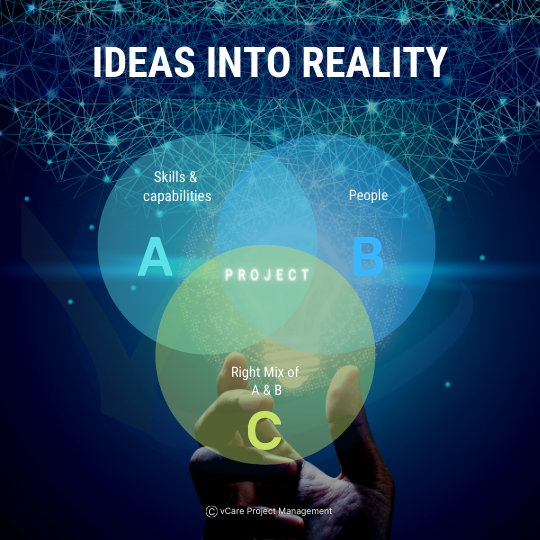
Ideas into Reality
The Project Economy at Work
The skills are utilized in project-based structures included in large organization’s portfolios and programs.
According to Professor and author Roger Martin, one of the world’s top-ranked management thinkers, this kind of approach is called “projectization,” where the everyday tasks become projects by themselves. Such trends are on the rise as “Gig Economy” is part of the project economy, which has been largely adopted by organizations like Ola, Uber, Airbnb, etc.,
People with varied skills, experience, and capabilities are brought onto one project to deliver value to the stakeholders. The resources are aligned at the portfolio level and mobilized to the projects on-demand based on priorities. Such an approach minimizes the cost of hiring, training, and retention. They all evolve into a high-performing workforce as they started merging into the socio-cultural aspects of the portfolio capabilities.

GIG ECONOMY
For example, companies like Zappos adopt a culture wherein the onboarded people or hired people are put onto their call centers to understand the various departments involved in the process and understand the pain they undergo. Post that, they will be able to get the context and core values of the organization, which were they can synchronize. It’s all about the task at hand than the title itself.
Vital skills in Project Economy
The Project Economy needs uniquely human skills such as leadership, creativity, and empathy.
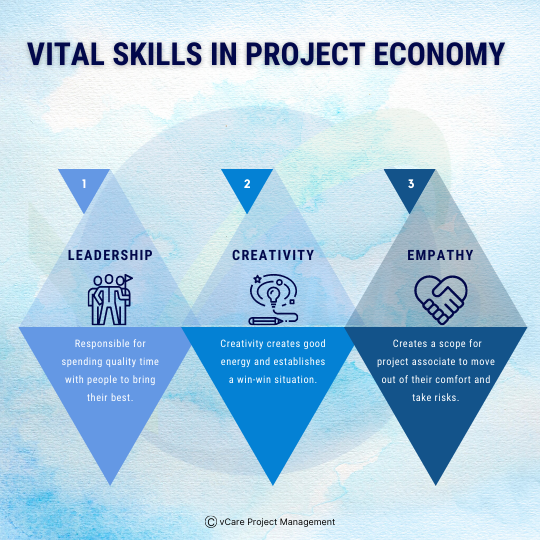
Vital skills in Project Economy
Leadership – Need to bring in the best of human potential. When the project economy is adopted, the people will move from role-based work to project-based work. As projects are going complex, a project manager is responsible for spending quality time with the people to bring their best.
Creativity – Creativity helps to find solutions to the problem in novel ways. Co-creation along with the stakeholders would minimize the postponement of decisions. It also extracts the thinking power of the participants creating new options. Creativity also creates good energy and establishes a win-win situation. Creativity can be fostered by providing an appropriate space to the team, decluttering the workplace, adopting a design thinking approach, etc… Foster an environment where creativity is recognized and rewarded
Empathy– When the project manager applies empathy, it creates scope for project associates to move out of their comfort zone and takes risks. It also brings on agility and helps reduces stress through minimized conflict. With empathy kindness and compassion becomes the natural ingredient promoting teamwork and leadership among individuals. Empathy can be exhibited by the project manager who is willing to be vulnerable and has the mindset to listen to all and exhibit leadership by walking the talk.
Project Economy Adoption
In the Middle East
There are many infrastructure projects already underway in the Middle East, such as Smart City, Higher Education, expansion of health care, etc… These projects bring changes to the digital infrastructure, transportation, and allied government service. Already in Dubai International Project Management Forum plays a vital role in megaprojects, including Construction of Digital Twin, Asset Project Management, BIM Implementation for Roads and Transportation Authority, Solar Park. All of these projects need people to execute. People are needed with the right skills to provide value to the stakeholders.
In the European Union
Case Study-1: Municipality located in Southern part of Sweden with more than 32000 inhabitants having organization size of 2400 full time and permanent employees have been organized as seven administrative departments. EU-funded projects were executed, and the projectification of departments, including public health, was achieved.
- The municipality has educated themselves and other organizations surrounding them, which helped effectively manage the EU funds and create competent project organization where employees make sense of their work.
- This move is transforming the civil servants, politicians to handle project activities affecting their organizing the style and overall impact on their performance routine.
- Implies changes where routines, or day-to-day activities, to an increasing extent are organized and understood, as if they were projects.
Case Study-2: Totally program worth 67.9 billion was allocated for the operational program through the EU. Territorial Self Government Units covering 57 offices were involved in a Survey related to identifying the benefits of Projectification
- Labor market institutions, up to 100% of offices declared that projects are never abandoned in the course of their lifetime
- In 96% of the projects, there was no change in the planned budget
- 89% of projects were completed according to the original schedule
- In 96% of the projects, there was no change in the planned budget
- Public organizations acting in this way make use of opportunities that arise in their environment, which proves their flexibility in adapting to changing conditions
- Changes in organizational structure are a temporary adaptation to the changes that have occurred in the external environment
Case Study-3: Automotive, Manufacturing, Engineering-Procurement-Construction (EPC), 2006 Football World Cup, Establishment of the Tsunami Early Warning System in South-East Asia.
- GPM study on projectification in Germany, almost 50% of working time in the manufacturing industry is spent on project work (GPM 2015)
- The project economy will generate 15% of value-added in Germany in 2020 (in 2007, it was 2%).
- The mean value shows that around 37% of all work processes in corporations are now organized in a project-oriented manner.
Summary:
As priorities change in these difficult times rapidly, project organizations need to embrace change. The Project Management office needs to build a team that commits to success. Project economy adoption is already a reality in various regions of the world. There are proven cases wherein successful projects are delivering values. Let’s focus on turning ideas into reality.
Feel free to check out my discussion on this topic with Dr. Reinhard Wagner in YouTube
You can subscribe and follow my podcasts and interviews with Project Management Experts on YouTube at https://bit.ly/2NDY8wd
You can subscribe to vCare Project Management YouTube Channel to catch future videos of our certification Q&A series and student success stories using the link https://bit.ly/2YF0wJl
For any questions related to Project Management career, training, and certifications, you can book an obligation free 15 minutes session with me by visiting talktodharam.com
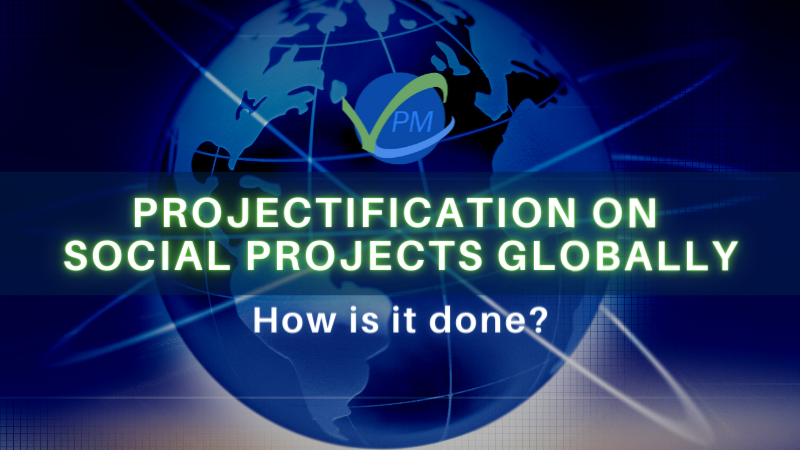
Projectification on social projects globally – How is it done? – Project Economy Series – Part 4
- Implementing public policies through projects is driven through global organizations such as World Bank, UNICEF, UN, etc., encouraging projectification practices that drive down activities vertically deep down.
- Implementation and deployment of public policies are time-framed. Hence, they are projectified.
- Projectification is seen as a key strategic measure for getting things done concerning the EU.
- OpenPM² is a project management methodology designed by the European Commission for interoperability solutions for public administrations, businesses, and citizens.
- We introduce projects to the public sector managers’ toolkit in the smallest offices and teach how to build project portfolios in the largest public units.
- The Polish public sector used the external funds and started to fully “think project-wise.” Because projectification of activities was a “sine qua non” condition, none of the countries joining the EU structures can fully integrate with them if there are no competencies regarding project management.
- To receive and implement a project, people have to organize themselves into teams – so projects build micro-communities and unite people around a common goal, often involving stakeholders who have so far been excluded.
Models such as GPM3 can help manage the implementation and evaluation of projectification efforts and their maturity, as given in the figure below.

Governmental Project Management Maturity Model (GPM3®)
Governmental Project Management Maturity Model (GPM3®)
A maturity model is the sequence of groups (levels) of more efficient practices in any activity area. Our base area for defining maturity levels are Governmental Project Implementation and Governmental Project Management treated together as one system. The first source of our inspiration was Capability Maturity Model Integrated (CMMI ©) – probably the first widely recognized and probably best-known maturity model. The second source of inspiration was the Organizational Project Management Maturity Model (OPM3©) – a maturity model for the organizational level.
Initial Level
Some governments are (really!) not interested in managing their projects and investments. They think it is enough to allocate the budget and set the deadline for product delivery, and people will know how to do it. We say about such governments that they are at the lowest, Initial level of project management maturity.
Local Level
At some moment, people in individual governmental agencies and organizations, worried about continuous failures of their projects and inefficient work, learn that efficient and effective project management methods exist. After some time, they manage to convince their organization executives that it is worth implementing them throughout the organization. If project management methods are implemented only in some governmental organizations, we say that the given government has reached the Local level of project management maturity.
Governmental Level
After some time, the cabinet learns that a few of its projects (either internal or foreign governments) were implemented more efficiently than anywhere else. This awareness resulted in implementing project management methods, techniques, and processes to work in all government projects. This way, project management maturity in that state reaches the Governmental level.
Cooperating Level
But should the government only define the ways of project implementation and passively observe the results of these processes? It is better if the government is actively involved in implementing projects, like trying to solve problems faced by – usually complex and complicated – government projects. Then we say that governmental project management has reached the Cooperating level.
Optimizing Level
But this is not the end of the journey to the top of the ladder of maturity. Everything can always be done better (if there is such a need). The most advanced governments – such as the US Federal Government – command its ministries and agencies to improve project (and program) management processes constantly. Then we say that the given government has reached the Optimizing level of project management maturity. And this description of progressively achieved levels of project management maturity (which can be observed in some countries) is called the Government Project Management Maturity Model (GPM3®).

Think global, Act local
Think global Act local: Committed project management individuals are experts at acquiring funding and coordinating support for their solution. In terms of projectification, these characteristics of the project champion are skills that are disseminated and encouraged across local government organizations. These Project Managers need to have the skills to cut across culture, language and have the ability to influence the groups for projectification.
Involve in fieldwork to get closer
- Connect with the local people at the ground level and understand the ground situation better for such implementations.
- Observe in the meeting and participate in meetings based on the dynamics involved with civil servants in different departments.
- Be available at the field level to have empathy towards the problem in projectification.
The more you become closer to them, the better operational goodness.

Fieldwork
Projectifications impact on BaU (Business as Usual)
- Activities are organized and realized as projects.
- Projects are the new form of work and mechanism for change.
- Enforcing the way of projectification through regulations, framework, and practices
- Projects in the public sector impact governance and help adopt previous best practices.
- Helps to identify and pilot a new way of work
- Helps developing new strategies and shaping the future for the society through innovation and joint learning, and
- In some cases, organizations might use projects for dealing with controversial issues that the permanent organization does not want to deal with.
Conclusion
In the global setting, Projectifications provide organizations with the ability to link multiple business partners and respond quickly to market demand and supplier needs while remaining flexible enough to anticipate and respond to rapid shifts in consumer preferences. The positive impact has been proven, so countries and its government need to enable the Civil Servants to become better project management and program management professionals for seamless projectification. This move would lead to a better economy, GDP and generate an extraordinary value stream across the government services.
Feel free to check out my discussion on this topic with Dr. Reinhard Wagner in YouTube
You can subscribe and follow my podcasts and interviews with Project Management Experts on YouTube at https://bit.ly/2NDY8wd
You can subscribe to vCare Project Management YouTube Channel to catch future videos of our certification Q&A series and student success stories using the link https://bit.ly/2YF0wJl
For any questions related to Project Management career, training, and certifications, you can book an obligation free 15 minutes session with me by visiting talktodharam.com
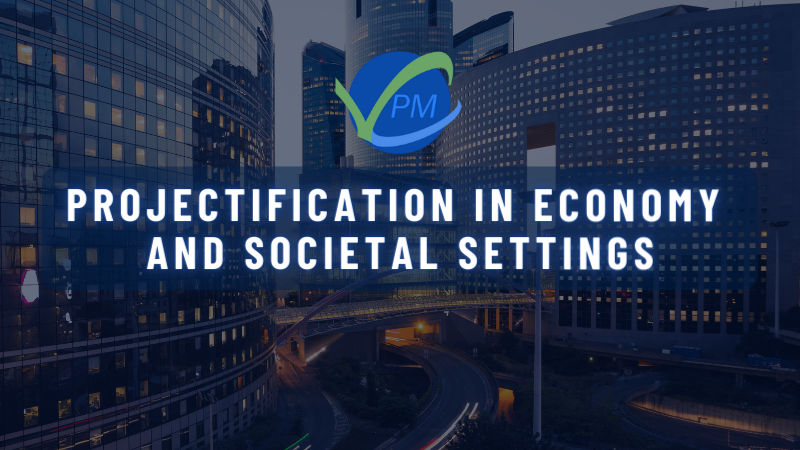
Project Economy – Part 3 – Projectification in Economy and Societal Setting
In the public sector, as Mats Fred (2018, p. 189) indicates:
Projectification as proliferation emphasizes the increasing use and diffusion of projects and project ideas. Projectification as transformation and adaptation highlights the transformation of “permanent” ordinary organizational activities to temporary projects and processes of adaptation in the surrounding organizations and structures. Projectification as an organizational capacity building in which the project logic is spread and diffused in local government organizations, not primarily through specific projects, but through practices encouraging the project logic and reinforcing local government’s organizational project capacity.
The term “Project” itself would be considered as a temporary endeavor. Projectification involves the cultural and discursive societal processes whereby projects and project-like circumstances are institutionalized in individual lives, organizing all sorts of work and society. They are to be planned, controlled, managed with dedication and commitment. In a societal setting, it calls for flexible action and task-focused social relations.
Understanding the Societal Setting

Understanding the Societal Setting
When the boundaries of the project go beyond the organization, societal settings come into place. Societal settings focus on developing and providing solutions together. When the projects are managed and executed at the societal level, it becomes a more collaborative effort. This kind of environment calls for global communication, collective intelligence, identifying skills across the board to leverage. Project execution should focus on accomplishing the tasks by adopting agile principles with empowering the team. The focus should be working through the community via effective networking.
Factors that could affect projectification in societal impact
- Temporary societal setup
There could be an influence at a Project Level, Political, Bureaucratic and Market Level. To a varying degree, local government involved in the societal settings would have specific practices that correspond to a political, bureaucratic, and market context. In terms of projectification, there could be complementary or contradictory aspects in nature that need to be managed well. Projectification translation could be done based out on specific settings and practices.
- Specific goals/focus
The societal context would have to manage multiple institutions yet need to bring them with a common goal and vision despite indifferences. This aspect needs to be dealt with using Decoupling, Compromising, and Combining depending on the situation and environment. These practices will de-escalate tensions in arriving at a consensus on the focus area or goals.
- Funding Challenges
The project budget needs to be derived from the policies wherein the costs are derived from the social investment funds. This action would mean cutting across the government and local bodies in the region. Sometimes these funds are advocated by World Bank, EU, IMF, etc… Using such funds would also call for strong coordination among the various stakeholders across different processes and procedures. Managing such funds could be tiresome and painful.
- Focus on implementation
Be in the realm of the project in the implementation context. It would look like a smooth sail as initiation would be easy on the ground implementation could be a posing challenge. Focus on the welfare benefits, lower costs for the larger group during the implementation. Understand the potential areas of resistance early in the project upon the various factors including economic, environmental, etc.,
- Managing Complexity
Projectification involves managing an organization to manage two types of complexity involving task complexity and Social complexity. Task complexity refers to the density of the units, causal links, and consequences within a temporal and spatial frame. Social complexity describes the number of members communicating and working with each other and the differentiation of their tasks. In contrast, cultural complexity encompasses the number of different historical experiences and sense-making processes confronting each other in a project.

Factors that could affect projectification in societal impact
The three projectification studies in Germany, Norway, and Iceland show that project work contributes to one-third of the national gross domestic product. Although differences exist among the countries regarding size and industry structure, the degree of projectification of advanced economies seems to converge on around one-third of all economic activities. The exact results showed that the share of project work in Germany was 34,7% in 2013, and 32,6% in Norway, and 27,7% in Iceland in 2014 (Schoper et al., 2018).
The projectification in the public or governance societal segment was more towards improving, modernizing the managerial approach towards the commoner or public. The projects were part of the public sector in the infrastructure area, such as Road Construction, Dam Construction, construction, and larger institutions, and their Projectifications are not sudden. Based on one of the research study by Schuster in 2015, he identified three key factors which seem to provide public/civil service organizations to adopt projectification. They are:
- Quick Mobilization
- Strategic approach towards managing the change
- Accountability and Transparency to stakeholders
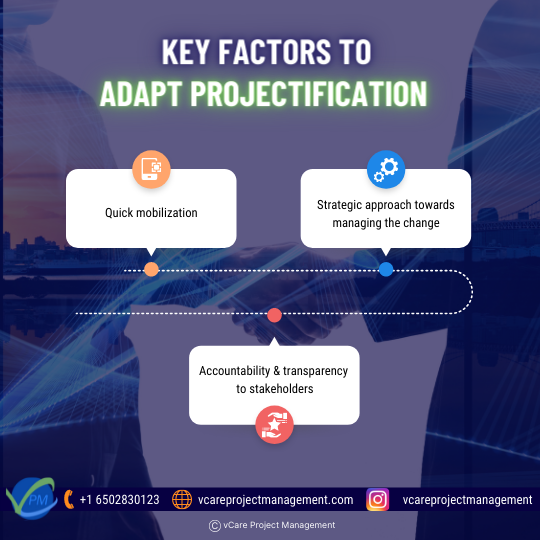
Key factors to adopt projectification
It is also to be realized that the ongoing social and economic change and the increase in public sector stakeholder’s innovation and entrepreneurship are most needed in this sector. Projectification helps to meet the void, which can help implement public policies, thus enabling changes in resolving social problems. Even though the benefits exist on projectification, it is not implemented due to the factors such as – Excess bureaucracy, Causes lack of trust, lack of persistence, etc.,
Conclusion
Projectification provides benefits to the people involved to know how to lead a team, influence people, and negotiate or resolve conflict. It would be a combination of more organizing activities to the organizations and transforming ordinary activities into projects. And increasingly, everybody needs to feel comfortable working in a digital environment.
Feel free to check out my discussion on this topic with Reinhard Wagner in YouTube
You can subscribe and follow my podcasts and interviews with Project Management Experts on YouTube at https://bit.ly/2NDY8wd
You can subscribe to vCare Project Management YouTube Channel to catch future videos of our certification Q&A series and student success stories using the link https://bit.ly/2YF0wJl
For any questions related to Project Management career, training, and certifications, you can book an obligation free 15 minutes session with me by visiting talktodharam.com





In the global setting, Projectifications allow organizations to link multiple business partners and respond quickly to market demand and supplier needs while remaining flexible enough to anticipate and respond to rapid shifts in consumer preferences. Here are some of its impacts on BaU,
• Activities are organized and realized as projects
• Projects are the new form of work and mechanism for change
• Enforcing the way of projectification through regulations, framework, and practices
• Projects in the public sector impact governance and help adopt previous best practices
• Helps to identify and pilot a new way of work
• Helps develop new strategies and shape the future of society through innovation and joint learning
• Organizations might use projects for dealing with controversial issues that the permanent organization does not want to deal with
🚀 Elevate Your Project Management Career:
– Register for my upcoming PMI Certifications Success Story Webinars:
1. Proven Portfolio Management Strategies featuring Scott McLeod – https://bit.ly/3Mx38kN
2. Dual PfMP & PgMP Success: Strategic Insights with Peter Kazimir – https://bit.ly/3ztTywc
3. From PMP to PgMP: Project to Program Management Transition featuring Moayad Alkhatib – https://bit.ly/4gLja8o
– Book an obligation-free consultation session on Project management Career, training, and certifications: http://talktodharam.com
– Discover training offers and certification discounts: https://bit.ly/3jWVepD
– Stay updated with our Q&A series and certification success stories by subscribing to the vCare Project Management YouTube channel at https://bit.ly/2YF0wJl
– Follow my podcasts and interviews with Project Management Experts on YouTube at https://bit.ly/2NDY8wd
#Projectification #BusinessAsUsual #ProjectEconomy #OrganizationalChange #AgileProjects #ProjectManagement #BusinessStrategy #GovernanceInProjects #PublicSectorProjects #InnovationInProjects #FlexibleWorkModels #RegulatoryFrameworks #FutureOfWork #ProjectBasedWork #StrategicChangeManagement #PgMP #PfMP #PMI #PMP #AskDharam #DharamSingh #VcareProjectManagement